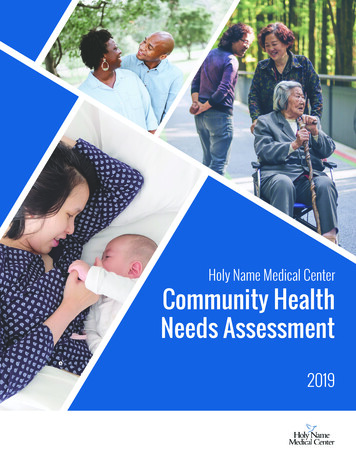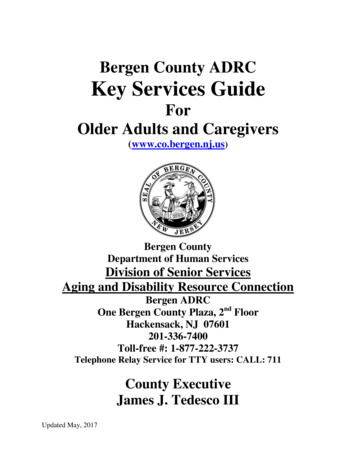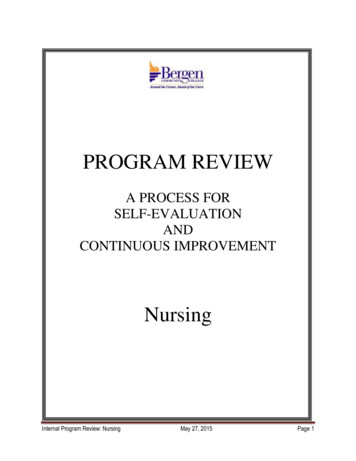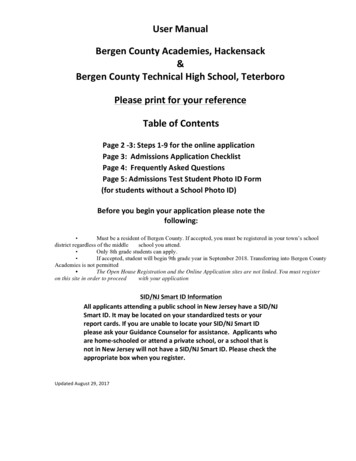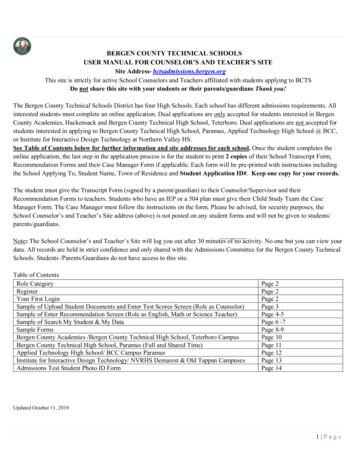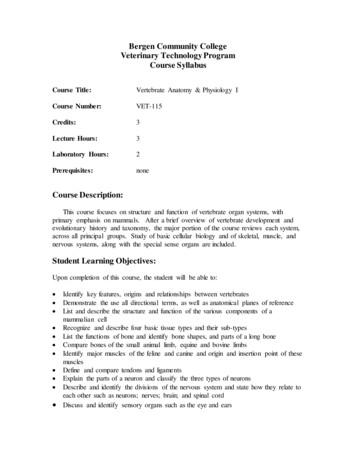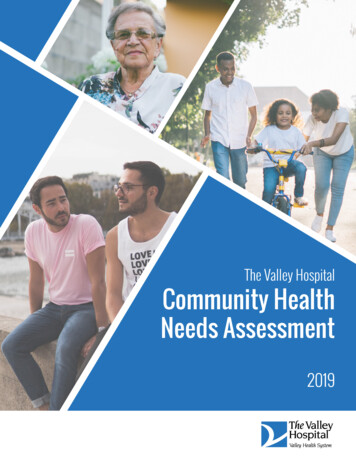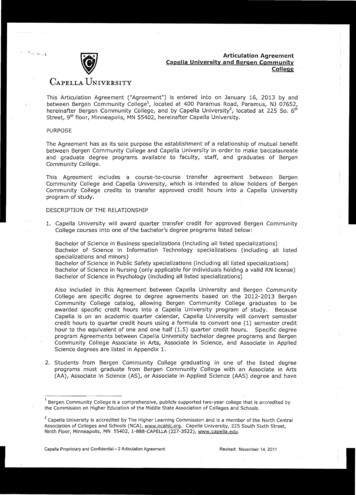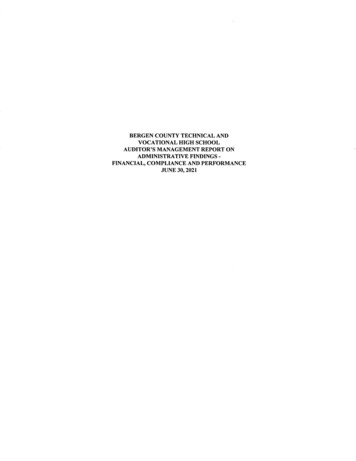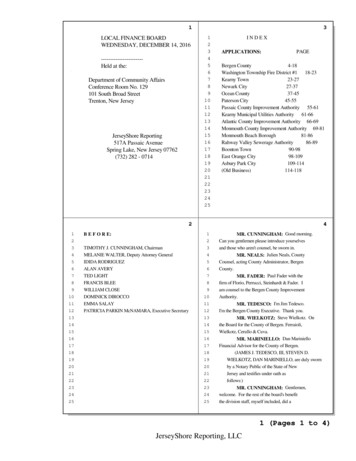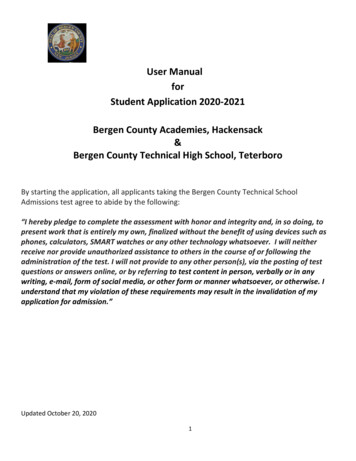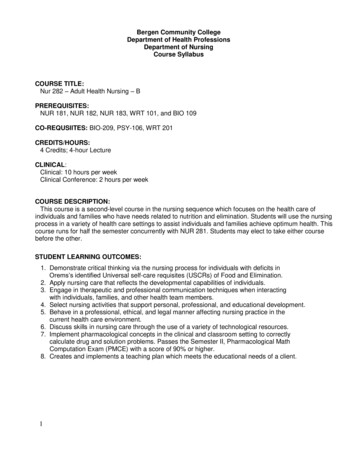
Transcription
Bergen Community CollegeDepartment of Health ProfessionsDepartment of NursingCourse SyllabusCOURSE TITLE:Nur 282 – Adult Health Nursing – BPREREQUISITES:NUR 181, NUR 182, NUR 183, WRT 101, and BIO 109CO-REQUSIITES: BIO-209, PSY-106, WRT 201CREDITS/HOURS:4 Credits; 4-hour LectureCLINICAL:Clinical: 10 hours per weekClinical Conference: 2 hours per weekCOURSE DESCRIPTION:This course is a second-level course in the nursing sequence which focuses on the health care ofindividuals and families who have needs related to nutrition and elimination. Students will use the nursingprocess in a variety of health care settings to assist individuals and families achieve optimum health. Thiscourse runs for half the semester concurrently with NUR 281. Students may elect to take either coursebefore the other.STUDENT LEARNING OUTCOMES:1. Demonstrate critical thinking via the nursing process for individuals with deficits inOrems’s identified Universal self-care requisites (USCRs) of Food and Elimination.2. Apply nursing care that reflects the developmental capabilities of individuals.3. Engage in therapeutic and professional communication techniques when interactingwith individuals, families, and other health team members.4. Select nursing activities that support personal, professional, and educational development.5. Behave in a professional, ethical, and legal manner affecting nursing practice in thecurrent health care environment.6. Discuss skills in nursing care through the use of a variety of technological resources.7. Implement pharmacological concepts in the clinical and classroom setting to correctlycalculate drug and solution problems. Passes the Semester II, Pharmacological MathComputation Exam (PMCE) with a score of 90% or higher.8. Creates and implements a teaching plan which meets the educational needs of a client.1
MEANS OF ASSESSMENT:The Student Learning Outcomes are assessed through various means of assessment, including but not limitedto the "Suggested Means of Assessment" listed below.Student Learning OutcomeMeans of Assessment1. Demonstrate critical thinking via the nursing process forindividuals with deficits inOrems’s identified Universal self-care requisites (USCRs) ofFood and Elimination.Lecture, Testing, ATI, Case studies, topicdiscussion, writing assignments, classparticipation/discussion2. Apply nursing care that reflects the developmentalcapabilities of individuals.Lecture, Care plan, Clinical Conference,class participation/discussion3. Engage in therapeutic and professional communicationtechniques when interactingwith individuals, families, and other health team members.4. Select nursing activities that support personal,professional, and educational development.Lecture, Clinical evaluation, classparticipation/discussion5. Behave in a professional, ethical, and legal manneraffecting nursing practice in thecurrent health care environment.Clinical evaluation, clinical conference,lecture6. Apply skills in nursing care through the use of a variety oftechnological resources.ATI, online The Point tutorials, clinical,clinical conference7. Utilize pharmacological concepts in the clinical andclassroom setting to correctlycalculate drug and solution problems. Passes the Semester II,Pharmacological MathComputation Exam (PMCE) with a score of 90% or higher.Testing, clinical, lecture8. Creates and implements a teaching plan which meets theeducational needs of a client.Teaching PlanATI tutorials, online reading, Lecture,class participation/discussionEVALUATION AND GRADING:A. Theory grade:Three-unit tests worth95%The average of 2 care plans5%Total100%A grade of C is required for passing theory portion of the course. Only answers on the scantron card will beaccepted.B. Clinical and Clinical Conference Attendance and Absence Policy All students will be reminded at the beginning of each clinical experience that they are required to attend ALLclinical laboratory AND clinical conference meetings or be in jeopardy of receiving a failing clinical grade. In order to pass clinical, the final grade must reflect a Satisfactory in all areas of the clinical evaluation.2
A student who receives an Unsatisfactory in any area will not pass the clinical component and will receive a finalgrade of “F” in the clinical nursing course regardless of the theory grade. Attendance is a part of the scoring ofthe clinical grade. In the category regarding professional behaviors, the following rules apply:Two absences a make-up assignment which will be developed by the clinical instructor and be equivalent tothe clinical hours missedThree absences failure of courseExceptional circumstances for clinical absences may be reviewed by the clinical instructor, team and ProgramDirector at the request of the student.A student should not call the College to report an absence. Faculty will inform students of the procedure to reportan absence for clinical laboratory or conference.C. Satisfactory demonstration on Foley catheterization skill validation: This includes insertion, removal,and obtaining a closed specimen.D. Adherence to Nursing Program attendance policy: see (Nursing Student Handbook).E. In order to pass the course, the student must receive:Theory grade of C Pass the Evaluation of Clinical Performance Pass the Foley Skill ValidationPass with 90% or greater the Pharmacology Math Computation Exam (PMCE)A 89.45 – 100B 85.45 – 89.44B 81.45 – 85.44C 77.45 – 81.44C 73.45 – 77.44D 69.45 – 73.44F 69.44 and belowRefer to Student HandbookLEVEL REQUIREMENT:Passing a Pharmacological Math Computation Exam (PMCE) with a score of 90% is a level requirement.The PMCE is comprise of 10 questions and will be given in the first course of each level. If the student does notattain the required 90% passing grade, he/she will be provided two retake opportunities within the confines ofthat course. Failure to achieve an 90% in the PMCE will result in an "F" for the course in which the test wasadministered. Calculators may be used at Level II.3
TEXTBOOKS:All textbooks from previous courses: NUR 181, NUR 182, and NUR 183. NUR 281/282Hinkle, J., & Cheever, K. (2018). Brunner & Suddarth's Textbook of Medical-SurgicalNursing (14th ed.). Philadelphia, PA: Wolters Kluwer.Mazur, E. (2019). Lutz's Nutrition and Diet Therapy (7th ed.). Philadelphia, PA: F.A. Davis.STUDENT SUPPORT SERVICESDistance Learning Office – forany problems you may haveaccessing your online coursesEnglish Language ResourceCenterThe Tutoring Center RoomRoom C334201-612-5581psimms@bergen.eduRoom C212http://www.bergen.edu/elrcL-125The Writing Center RoomL-125The Office of SpecializedServices (for Students withDisabilities)BCC Library – Reference DeskRoom ://www.bergen.edu/ossRoom L-226201-447-7436STATEMENT ON ACCOMMODATIONS FOR DISABILITIESBergen Community College aims to create inclusive learning environments where all students have maximumopportunities for success. Any student who feels he or she may need an accommodation based on the impactof a disability should contact the Office of Specialized Services at 201-612-5269 or via email atossinfo@bergen.edu for assistance.4
Additional learning resources available to supplement classroom lecture, reading, discussion, and self-study.I. The Point Practice and Learn Activities: Student resources - GI/GUChapter 44Chapter 46Chapter 47Chapter 47Chapter 49Chapter 50Chapter 51Chapter 54Chapter 54Chapter 55II.Digestive and Gastrointestinal Treatment ModalitiesManagement of Patients With Gastric and Duodenal DisordersManagement of Patients With Intestinal and Rectal DisordersManagement of Patients With Intestinal and Rectal DisordersAssessment and Management of Patients With Hepatic DisordersAssessment and Management of Patients With Biliary DisordersAssessment and Management of Patients With DiabetesManagement of Patients With Kidney Disorders/AKIManagement of Patients With Kidney Disorders/CKDManagement of Patients With Urinary DisordersATI (electronic text) Video Case StudiesUrinary Tract Infections,Enteral Nutrition, Nutrition,Total Parenteral NutritionIII. ATI Skills ModuleCentral Venous Access DeviceDiabetes ManagementEnteral Tube FeedingsNasogastric IntubationNutrition, Feeding, and EatingUrinary Catheter CareIV. ATI Targeted AssessmentsTargeted Medical-Surgical 2016: GastrointestinalTargeted Medical- Surgical 2016: Renal and UrinaryV.Journal Articles: Available on The PointVI. Nursing Tutorial (NT) are available in the Library. These NCLEX-RN (Judy MillerTapes) Review streaming video and DVD Discs DVD Disc's are available on thefollowing Topics:Test Taking SkillsGastrointestinal SystemGenitourinary SystemVII. NUR 282 MoodleQuicktime movies on: Foley catheter insertion, Foley catheter removal, Specimencollection closed technique from a Foley catheter.5
COURSE OUTLINETheoretical ContentTeaching/Learning ActivitiesPART I: THE USCR FOR FOODUNIT I: THE GASTROINTESTINAL SYSTEMPrior to the start of this unit, review the anatomy andphysiology of the gastrointestinal system.I. Definition of USCR for foodRead: Assessment course text - Chapter on NutritionalAssessmentII. Assessment of Digestive & Gastrointestinal FunctionA.Health historyB.Physical examC.Diagnostic studies and related nursingresponsibilities (i.e. consents, SupportiveEducative Nursing Systems for testpreparations.) (SENS)1.radiological2.endoscopy3.liver biopsy/function4.blood chemistryIII. Normal NutritionA.Components of the basic food utritional Needs of AdultsC.Nutrient imbalancesIV.Digestive & Gastrointestinal Treatment ModalitiesA.Review assessmentB.Identification of self-care deficits and relatednursing diagnosesC.Nursing interventionsD.Gerent logical considerationsE.Iron Deficiency AnemiaF.Pernicious AnemiaG.Supplemental nutrition1.oral feeding2.enteral feeding3.TPN4.surgery6Read: Fundamental Text – Chapter on NutritionRead: Brunner – Unit: Digestive and GastrointestinalFunction Chapters 43Read: Lutz– Chapters 1 – 9, 12, 13, 14 and 15Read: Pharmacology course text – Chapter on DrugsAffecting the Gastrointestinal SystemBrunner: Watch & Learn Videos - Chapter 43: Assessment ofDigestive and Gastrointestinal Function, Video: Assessing theAbdomenATI Skills Module:Enteral Tube FeedingsNasogastric IntubationNutrition, Feeding, and EatingCentral Venous Access DeviceBrunner Chapter 44Read: Lutz, Chapter 15ATI (electronic text) Video Case StudiesEnteral Nutrition NutritionTotal Parenteral Nutrition NutritionThe Point Practice and Learn Activities: Student resources GI/GU Chapter 44: Digestive and GastrointestinalTreatment ModalitiesThe Point - Watch & Learn Videos Chapter 44: Digestive and GastrointestinalTreatment Modalities, Video: Nutrition: Insertinga Nasogastric Tube Chapter 44: Digestive and GastrointestinalTreatment Modalities, Video: Nutrition:Administering a Continuous Tube Feeding Usinga Feeding Pump and a Prefilled, Closed Tube.
Theoretical ContentTeaching/Learning ActivitiesUNIT I: THE GASTROINTESTINAL SYSTEMV. Assessment & Management with Patients with ObesityA.B.Review Pathophysiology, ClinicalManifestations, Diagnostic StudiesTherapeutic/nursing management1.calorie-restricted diets2.exercise3.behavior modification4.surgeryUNIT II: PROBLEMS OF INGESTIONVI. Management of Patients with Oral & EsophagealDisordersI.Dental problemsI.Mandibular fracturesII.Read: Brunner, Chapter 48Gastroesophageal reflux disease (GERD)Clinical manifestationsTherapeutic management1.diet2.drugsC.Nursing ManagementRead: Brunner, Chapter 45Read: assessment course text – Assessment of the Abdomen.Read: Lutz, Chapter 14A.B.III.Hiatal herniaReview Pathophysiology, Clinical ManifestationDiagnostic StudiesB.TypesC.Therapeutic and nursing managementA.IV.V.Esophageal disordersGastrostomyTypes of tubesFeedingSkin careA.B.C.VI.Food poisoningUNIT III: PROBLEMS OF DIGESTIONManagement of Patients with Gastric & Duodenal DisordersI.Nausea and vomitingRead: Brunner, Chapter 46A.B.C.II.7Therapeutic managementNutritional managementNursing managementAcute gastritisA.Review Pathophysiology, ClinicalB.Manifestation, Diagnostic StudiesC.Therapeutic managementD.Nursing management
Fall 2019/Spring 2020-NUR 282Theoretical ContentTeaching/Learning ActivitiesUNIT IV: PROBLEMS OF INGESTION (Continued)III.Upper GI h/duodenumsystemic diseasesTherapeutic management1.drugs2.surgeryNursing assessmentIdentification of self-care deficits and relatednursing diagnosesNursing interventionsRead: Brunner, Chapter 46The Point Practice and Learn Activities: Chapter 46: Management of Patients WithGastric and Duodenal Disorders, Practice and LearnInteractive Case Studies: Peptic UlcerPeptic ulcers – gastric and duodenalA.Review Pathophysiology, ClinicalManifestation, Diagnostic StudiesB.Complications1.perforation2.gastric outlet obstructionC.Therapeutic management1.drugsa)antacidsb)H2 receptor antagonistsc)anticholinergics2.surgical managementD.Nursing assessmentE.Nursing interventions1.relieve discomfort2.recognize complicationsa)dumping syndromeb)postprandial hypoglycemia3.dietUNIT V: PROBLEMS OF THE LIVER, BILIARY TRACKAND PANCREASAssessment & Management of the Patient with Hepatic DisordersRead: Brunner, Chapter 49I.JaundiceII.HepatitisA.B.C.D.E.8TypesReview Pathophysiology, ClinicalManifestation, Diagnostic StudiesTherapeutic management1.drugs2.dietNursing assessmentIdentification of SCD and related NDsThe Point Practice and Learn Activities: Chapter 49: Assessment and Managementof Patients With Hepatic Disorders
Fall 2019/Spring 2020NUR 282Theoretical ContentUNIT VI: PROBLEMS OF THE LIVER, BILIARY TRACTAND PANCREASAAssessment & Management with Patients with BiliaryDisordersII.Hepatitis (continued)F.Nursing interventions1.relieve discomfort2.skin care3.restIII.Cirrhosis of the liverA.Review of Pathophysiology, ClinicalManifestation, Diagnostic StudiesB.Complications1.ascites2.esophageal varices3.hepatic encephalopathyC.Therapeutic management1.peritoneovenous shunt2.endoscopic .Nursing assessmentE.Identification of SCD and related NDsF.Nursing interventions1.relieve discomfort2.promote rest3.observe for complicationsIV.PancreatitisA.Review Etiology, Pathophysiology,Clinical Manifestation, essC.Therapeutic managementD.Nursing assessmentE.Identification of SCD and related NDsF.Nursing interventions1.relieve pain2.promote fluid and electrolytebalance3.observe for complications4.SENS to prevent recurrence9Read: Brunner, Chapter 50The Point Practice and Learn Activities: Chapter 50: Assessment andManagement of Patients With Biliary Disorders.
Fall 2019/Spring 2020-NUR 282Theoretical Content Teaching/Learning ActivitiesUNIT VII: PROBLEMS OF THE LIVER, BILIARY TRACT ANDPANCREAS - contV.Disorders of the Biliary TractA.Gallbladder disease1.review Pathophysiology, ClinicalManifestation, Diagnostic Studies2.complicationsB.Therapeutic managementC.Nursing assessmentD.Identification of SCD and related NDsE.Nursing interventionUNIT VIII: DIABETESAssessment & Management of Patients with DiabetesA.Review Pathophysiology, Clinical ManifestationDiagnostic StudiesB.Classification1.type I2.type IIC.Complications1.acute2.chronicD.Therapeutic management1.diet2.drugs3.exercise4.glucose monitoring5.foot careE.Nursing interventionsF.Identification of SCD and related NDsG.Nursing interventions1.prevent acute/chroniccomplications2.SENS to manage diseaseRead: Brunner – Chapter 50 Read: Lutz – Chapter 17Read: Brunner, Chapter 51Read: Pharmacology course text – Drugs affectingthe Endocrine System: Diabetic MedicationsThe Point Practice and Learn Activities: Chapter 51: Assessment and Management ofPatients With DiabetesBrunner: Watch and Learn - Chapter 51: Assessment andManagement of Patients With Diabetes.7 DVDs located in Library1. Physiology of Glucose Regulation2. Pathology of Diabetes3. Nutrition Therapy, Exercise and Sick DayManagement4. Insulin and Oral Antidiabetic Agents5. Hypoglycemia and Monitoring6. Neuropathy, Nephropathy and Retinopathy7. CVD and the Diabetic FootATI Skills Module: Diabetes ManagementPART II: THE USCR FOR ELIMINATIONUNIT I: PROBLEMS OF BOWEL ELIMINATIONManagement of Patients with Intestinal & Rectal DisordersRead: Brunner, Chapter 47I.Definition of the USCR for bowel eliminationII.Diarrhea and constipationA.ConstipationB.Diagnostic studies and related nursingresponsibilities (i.e. consents, SENS for testpreparations, etc.)1.x-rays2.barium enema3.colonoscopy4.sigmoidoscopy10Read: Pharmacology course text – Drugs Affecting theGastrointestinal SystemThe Point Practice and Learn Activities: Chapter 47: Management of Patients WithIntestinal and Rectal Disorders
Fall 2019/Spring 2020NUR 282Theoretical ContentII.III.Diarrhea and constipation (continued)C.Therapeutic management1.drug therapy2.dietD.Nursing assessmentE.Identification of SCD and related NDsF.InterventionsNoninflammatory intestinal disordersA.HerniasB.Intestinal obstruction1.mechanical2.nonmechanicalC.Abdominal traumaD.PolypsE.HemorrhoidsIV.Inflammatory intestinal disordersA.AppendicitisB.PeritonitisC.Ulcerative colitisD.Crohn's diseaseE.Diverticular diseaseV.Anal disordersVI.Therapeutic managementA.DietB.Drug therapyC.Surgery1.colostomy, ileostomy2.colon resectionD.Nursing assessmentE.Identification of SCD and related NDsF.Nursing interventions11Teaching/Learning ActivitiesClassroom Case Study Assignments AppendicitisGI Bleed IleostomySmall bowel obstructionBrunner: Watch and Learn Chapter 47: Management of Patients With Intestinal andRectal Disorders, Video: Bowel Elimination: Changing anOstomy Appliance Chapter 47: Management of Patients With Intestinaland Rectal Disorders, Video: Caring for a Patient WithDiverticulitisThe Point Practice and Learn Activities: Chapter 47: Management of Patients WithIntestinal and Rectal DisordersTake the Targeted ATI Assessment:Targeted Medical-Surgical 2016: Gastrointestinal.Hand in to the professor by the end of the last class.
UNIT II: PROBLEMS OF URINARY ELIMINATIONAssessment of Kidney & Urinary FunctionI.Definition of the USCR for urinary eliminationII.AssessmentA.Health historyB.Physical examC.Diagnostic studies and related nursingresponsibilities (i.e. consents, SENS for testpreparations, etc.)1.urine studies2.blood chemistries3.radiologic studies4.renal scans5.endoscopies6.renal biopsyRead: Brunner, Chapter 53Read: Lutz – Chapter 19Read: Pharmacology course text – Drugs Affecting theRenal System; Drugs Used to Treat Infections Urinary Antiseptic Agents.ATI Skills Module: Urinary Catheter CareBrunner, Chapter 55Assessment of Patients with Urinary DisordersIII.Infections isLower1.2.C.D.E.ATI Skills Module: Urinary Tract InfectionsCystitisUrethritisSourcesClinical manifestationsTherapeutic managementIV.GlomerulonephritisV.Obstructive uropathies-Urinary and renal calculiVI.Urinary incontinenceVII.The Point Practice and Learn Activities: Chapter 55Management of Patients WithUrinary DisordersWatch and Learn: Chapter 55: Management of Patients WithUrinary Disorders, Video: Urinary Elimination: Applying aCondom Catheter Chapter 55: Management of Patients WithUrinary Disorders, Video: Urinary Catheters: Catheterizingthe Male Urinary Bladder: Indwelling and IntermittentCatheters.Problems of the prostate glandA.Benign prostatic hypertrophyB.Prostatitis1. Review Pathophysiology, Clinical Manifestation,Diagnostic Studies2. Drug therapyVIII. Surgery of the urinary tractA. Ileo-conduitB. Prostatic surgeryC.Pre and postoperative care12ATI Skills Module: Ostomy Care
Theoretical ContentTeaching/Learning StrategiesX. Nursing assessmentXI. Identification SCD and related NDsXII. Nursing interventionsUNIT III: RENAL INJURY/FAILUREManagement of patients with Kidney DisordersA.Acute1.pathophysiology2.clinical coursea)oliguric phaseb)diuretic phasec)recovery phase3. diagnostic studiesB. ChronicC. Dialysis1.peritoneal2.hemodialysisD. Nursing assessmentE. Identification of SCD and related NDsF. Nursing interventions and effect of deficit on otherUSCR'sG. Therapeutic/nursing management1.drug therapy2.dietH. Transplantation7Brunner, Chapter 54The Point Practice and Learn Activities: Chapter 54: Management ofPatients With Kidney Disorders/AKI Chapter 54: Management of Patients WithKidney Disorders/CKD Watch and Learn:Chapter 54: Management of Patients WithKidney Disorders, Caring for a Patient following an AV ShuntPlacementTake the Targeted ATI Assessment:Targeted Medical-Surgical 2016: Renal and UrinaryHand in to the professor by the end of the last day.
Bergen Community College Department of Health Professions Department of Nursing Course Syllabus COURSE TITLE: Nur 282 - Adult Health Nursing - B PREREQUISITES: NUR 181, NUR 182, NUR 183, WRT 101, and BIO 109 CO-REQUSIITES: BIO-209, PSY-106, WRT 201 CREDITS/HOURS: 4 Credits; 4-hour Lecture CLINICAL: Clinical: 10 hours per week
